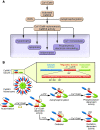CaMKII and a failing strategy for growth in heart
- PMID: 19422097
- PMCID: PMC2673844
- DOI: 10.1172/jci39262
CaMKII and a failing strategy for growth in heart
Abstract
Patients with systolic left ventricular dysfunction die progressively from congestive heart failure or die suddenly from cardiac arrhythmias. Myocardial hypertrophy is an early event in most forms of heart failure, but the majority of patients with myocardial hypertrophy do not develop heart failure. Developing improved therapies for targeting the cell signaling pathways that enable this deadly transition from early myocardial insult to heart failure and sudden death is a key goal for improving public health. In this issue of the JCI, Ling and colleagues provide new evidence that activation of the multifunctional Ca(2+)/calmodulin-dependent kinase IIdelta is a decisive step on the path to heart failure in mice (see the related article beginning on page 1230).
Figures

Comment on
-
Requirement for Ca2+/calmodulin-dependent kinase II in the transition from pressure overload-induced cardiac hypertrophy to heart failure in mice.J Clin Invest. 2009 May;119(5):1230-40. doi: 10.1172/JCI38022. Epub 2009 Apr 20. J Clin Invest. 2009. PMID: 19381018 Free PMC article.
References
Publication types
MeSH terms
Substances
Grants and funding
LinkOut - more resources
Full Text Sources
Medical
Miscellaneous

